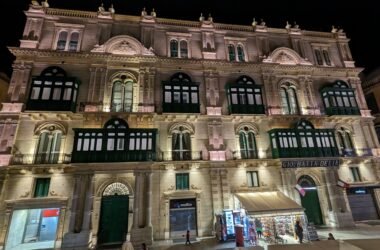We’re pleased to introduce today an exclusive report by Expatax Malta shedding light on what’s been happening with Maltese property prices since March 2020. By tracking thousands of property listings across Malta and Gozo from 2020 to 2025, we’ve created a proprietary index that reveals the true market dynamics at a granular level.
What we found is anything but uniform. In a country you can drive across in under an hour and still complain about the traffic, property prices have diverged significantly by location and type. Gozo saw apartment prices cool or stagnate, others posted double-digit growth, contradicting the broad-brush trends often quoted from national averages in the media.
Yes, between 2013 and 2023, Malta’s average property prices surged by 125%, with apartments leading the charge-rising from ~€100,000 to over €225,000. But our data shows this decade-long boom masks substantial local variations, especially over the past five years.
Maltese Apartment Price Boom (and One Notable Bust)
Apartments across Malta have broadly appreciated, with one headline exception: Gozo. Here’s what the data says:
![[EXCLUSIVE] Malta and Gozo Property: Prices Soared by up to 70% Between 2020 and 2025 2 apartment price distribution 2025 malta 2](https://expatax.mt/wp-content/uploads/2025/06/apartment_price_distribution_2025_malta-2-1024x609.png)
These urban zones, especially Sliema/St. Julian’s, continue to attract both local professionals and foreign investors. The surge likely reflects high demand for proximity to business hubs, sea views, and luxury amenities.
![[EXCLUSIVE] Malta and Gozo Property: Prices Soared by up to 70% Between 2020 and 2025 3 apartment price change 20 25 2 1](https://expatax.mt/wp-content/uploads/2025/06/apartment_price_change_20-25-2-1-1024x605.png)
Apartments are the core of Malta’s housing market. They dominate transactions and rental stock. And in the past five years, prices have soared – except in Gozo.
Sliema & St Julian’s: €375,000 → €650,000 (+73%)
North Region: €265,000 → €375,000 (+42%)
Central Malta: €265,000 → €365,000 (+38%)
South Malta: €250,000 → €320,000 (+28%)
Gozo: €225,000 → €220,000 (–2%)
The absolute jump of €275,000 in Sliema & St Julian’s is more than the full value of an apartment in Gozo. Even more striking is how this pattern mirrors broader demographic and economic dynamics. According to the National Statistics Office, population growth between 2020 and 2024 was concentrated in the Northern and Central Harbour areas, further validating our findings.
Houses Prices: Broad Growth, Slower Turnover
![[EXCLUSIVE] Malta and Gozo Property: Prices Soared by up to 70% Between 2020 and 2025 4 house price distribution 2025 malta 1](https://expatax.mt/wp-content/uploads/2025/06/house_price_distribution_2025_malta-1-1024x609.png)
House prices also grew strongly, though the spread was greater. These properties trade less frequently and typically cater to lifestyle buyers, upsizing families, and the occasional romantic with renovation dreams.
![[EXCLUSIVE] Malta and Gozo Property: Prices Soared by up to 70% Between 2020 and 2025 5 house price change 20 25 1](https://expatax.mt/wp-content/uploads/2025/06/house_price_change_20-25-1-1024x605.png)
Sliema & St Julian’s: €922,500 → €1.44m (+56%)
South Malta: €520,000 → €797,000 (+53%)
North Malta: €1.25m → €1.90m (+52%)
Central Malta: €714,500 → €920,000 (+29%)
Gozo: €500,000 → €620,000 (+24%)
While the houses appreciated more in absolute terms, the liquidity is lower. Our charted data suggests that demand for houses is more event-driven: upsizing families, expatriates with long-term plans, or those seeking lifestyle properties.
Maltese House Price Increased Less than Apartment Prices
Apartments dominate transactions and deliver better returns in prime areas. Houses did grow strongly in select zones, but are slower to sell and rent. In our data, house prices rose by an average of +35.3% across Malta (excluding Gozo), compared to +42.7% for apartments. Apartments in Malta also saw greater volume and tighter spreads.
Interestingly, this diverges from markets like Ireland or Portugal, where post-COVID demand for space boosted house prices more. In Malta, the compact size and persistent urban job concentration meant apartments never fell out of favour.
Understanding Malta and Gozo’s Property Market Distinctions
For non-locals, here’s a quick overview of how the islands divide up—and why demand differs so greatly in such a small country:
Sliema & St Julian’s: Malta’s commercial and leisure hub. High density, high rents, strong capital appreciation. Popular with professionals, tourists, landlords, and short-let operators.
North Region (e.g. Mellieħa, St Paul’s Bay): A mix of residential and holiday zones, popular with families and part-time residents. Offers relatively good connectivity to Valletta.
Central Malta (e.g. Mosta, Birkirkara): Densely populated, locally driven market with strong public services and stable year-round demand.
South Malta (e.g. Marsaskala, Żabbar): Traditionally more affordable. Gaining interest but still underperforms on price growth. Appreciation in apartments has been one third less than an apartment in Sliema
Gozo: Malta’s rural sister island. Beautiful but less connected. Offers tranquillity, lower prices, and limited rental yield. Favoured by retirees and cash buyers, less so by investors. And the ferry remains a psychological barrier for those looking to relocate.
What is Driving the Property Prices? Let’s Start With People
Malta’s population has grown by nearly 40% since 2000—one of the fastest rates in Europe. And that growth isn’t just from births. In 2012, just over 8% of workers in Malta were foreign. By 2022, that figure had jumped to 33%. According to the NSO nearly 97,000 foreign workers are now part of Malta’s 296,000-strong labour force. These workers don’t typically move to Gozo. They cluster around the economic hubs like the tech, iGaming, and finance clusters which are centred around the Sliema, Gżira and St Julian’s. This has drawn sustained rental demand and investor interest, and push property prices up.
Tourist Wave Drives Property Prices Up
![[EXCLUSIVE] Malta and Gozo Property: Prices Soared by up to 70% Between 2020 and 2025 7 Mellieha Bay beach Malta 1](https://expatax.mt/wp-content/uploads/2025/06/Mellieha_Bay_beach_Malta_1-1024x569.jpg)
In 2024, Malta saw a record 3.56 million inbound tourists, up 19.5% from the year before. And most of them didn’t bring a tent! Sliema and St Julian’s have strong occupancy rates and top nightly yields, keeping buy-to-let yields healthy, often 5% or more.
According to NSO Q4 2024 accommodation data, 98% of non-resident stays were in Malta, and just 2% in Gozo. This means constant demand for short-lets in coastal zones like Sliema, St Paul’s Bay, and Valletta. So once again it’s Malta, not Gozo, that remains a favourite for both tourists and the investors serving them. The increased demand, coupled with tight supply leads to greater price increases for apartments and houses in these areas.
Space: The One Thing Malta Doesn’t Have More Of
Malta’s geography does the rest. Urban zones like Sliema and Gżira are basically out of land. New supply is limited to redevelopments or vertical builds. Gozo, by contrast, has plenty of space and far fewer constraints.
The result? Apartments in Malta appreciate faster because demand keeps running into a wall of physical limits. Gozo has more undeveloped sp but attracts less, which keeps prices soft and stable.
Sliema vs Gozo: The Maltese Property Price Gap That Says It All
Expatax’s 2025 price range analysis the confirms the bifurcation.
- Sliema & St Julian’s: Median apartment prices above €600,000, with outliers nearing €2 million
- Gozo: Median apartment prices just over €200,000, slightly down since 2020
In 2020, the median gap was around €150,000. By 2025, it reached nearly €400,000. This reflects everything: demand, income flows, tourism, scarcity, and connectivity, showing investor preferences heavily skewed toward urban, amenity-rich zones in Malta.
Outlook: Can Property Prices Continue to Rise in Malta?
Several factors have underpinned Malta’s robust property market on the demand side. Foreign investment has played a major role, drawn by the island’s strategic location, English-speaking workforce, and favourable tax regime. Government incentives, including schemes for first and second-time buyers and targeted support for Urban Conservation Areas and Gozo, have further stimulated demand. Strong economic growth has added fuel to the fire—sectors like iGaming, finance, and tourism have flourished, with tourism alone contributing €2.6 billion to GDP in 2023.
Growth is likely to slow but remain positive as supply is tighter than demand. With 26,000 new units permitted between 2020–2024 and affordability tightening, we expect a plateau in overbuilt zones. That said, zones like Sliema and Valletta have natural caps on supply. Expect continued bifurcation:
- A-list zones will stabilise at high levels.
- Peripheral areas may see modest corrections or flat growth.
Gozo remains a wildcard. Its stability makes it attractive to cash buyers and retirees, but without stronger connectivity or economic pull, gains look to remain modest.
Final Thought
Malta is tiny. But its property market isn’t. Our research shows a story of two archipelagos: one fuelled by global capital and lifestyle demand, the other moving at a slower local rhythm. Investors who recognise this and act accordingly will find opportunity, if not the bargains of yesteryear.




![[EXCLUSIVE] Malta and Gozo Property: Prices Soared by up to 70% Between 2020 and 2025 1 The Quad Malta](https://expatax.mt/wp-content/uploads/2025/06/The_Quad_Malta-800x500.jpg)



